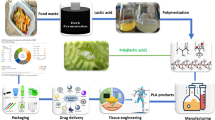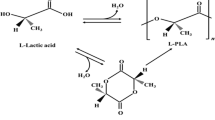Abstract
Biodegradable poly{3,4-dihydroxycinnamic acid (DHCA, coffeic acid)-co-lithocholic acid (LCA)} polyester was synthesized by polycondensation of DHCA and LCA. The molecular structure of poly(DHCA-co-LCA) copolymers was characterized by FT-IR and 1H-NMR measurement. The photo-crosslinkability of poly(DHCA-co-LCA) depended on their compositions and could be tuned by varying the monomer ratio. The presence of LCA in the copolymers enhanced the solubility and thermal stability. In addition, poly(DHCA-co-LCA) and PDHCA exhibited higher fluorescence emission intensity than DHCA monomer. Accelerated hydrolysis experiments revealed that the degradation rate of poly(DHCA-co-LCA) was slower than that of PDHCA.









Similar content being viewed by others
References
Shalaby SW, Burg KJL (eds) (2003) Absorbable and biodegradable polymers (advances in polymeric materials). CRC, Boca Raton
Piskin E (1995) Biodegradable polymers as biomaterials. J Biomater Sci Polym Ed 6(9):775–795
Li Bo-Hsin, Yang M-C (2006) Improvement of thermal and mechanical properties of poly(L-lactic acid) with 4, 4-methylene diphenyl diisocyanate. Polym Adv Technol 17:439–443
Haderlein G, Petersen H, Schmidt C, Wendorff JH, Schaper A, Jones DB, Visjager J, Smith P, Greiner A (1999) Synthesis and properties of liquid crystalline aromatic copolyesters with lactide moieties. Macromol Chem Phys 200:2080–2087
Wiltshire JT, Qiao GG (2006) Selectively degradable core cross-linked star polymers. Marcomolecules 39:9018–9027
Thronton PD, Mart RJ, Ulijn RV (2007) Enzyme-responsive polymer hydrogel particles for controlled release. Adv Mater 19(9):1252–1256
Jiang J, Qi B, Lepage M, Zhao Y (2007) Polymer micelles stabilization on demand through reversible photo-cross-linking. Macromolecules 40(4):790–792
Shi DJ, Matsusaki M, Akashi M (2009) Unique size-change behavior of photo-crosslinked cinnamic acid derivative nanoparticles during hydrolytic degradation. Macromol Biosci 9:248–255
Kaneko T, Tran HT, Matsusaki M, Shi DJ, Akashi M (2006) Environmentally degradable, high-performance thermoplastics from phenolic phytomonomers. Nat Mater 2006(5):996
Matsusaki M, Tran HT, Kaneko T, Akashi M (2005) Enhanced effects of lithocholic acid incorporation into liquid-crystalline biopolymer poly(coumaric acid) on structural ordering and cell adhesion. Biomaterials 26:6263–6270
Kaneko T, Tran HT, Matsusaki M, Akashi M (2006) Biodegradable LC oligomers with cranked branching points form highly oriented fibrous scaffold for cytoskeletal orientation. Chem Mater 18:6220–6226
Hoff WD, Dux P, Hard K, Devreese B, Nugteren Roodzant IM et al (1994) Thiol ester-linked p-coumaric acid as a new photoactive prosthetic group in a protein with rhodopsin-like photochemistry. Biochemistry 33(47):13959–13962
Tran HT, Matsusaki M, Shi DJ, Kaneko T, Akashi M (2008) Synthesis and properties of coumaric acid derivative homo-polymers. J Biomater Sci Polym Ed 19:75–85
Tran HT, Matsusaki M, Akashi M (2008) Thermally stable and photoreactive polylactides by the terminal conjugation of bio-based caffeic acid. Chem Commun 3918–3920
Tran HT, Matsusaki M, Akashi M (2009) Development of photoreactive degradable branched polyesters with high thermal and mechanical properties. Biomacromolecules 10:766–772
Sun J, Mustafi R, Cerda S, Chumsangsri A, Xia Y, Li YM, Bissonnette M (2008) Lithocholic acid down-regulation of NF-kB activity through vitamin D receptor in colonic cancer cells. J Steroid Biochem Mol Biol 111(1–2):37–40
Ishizawa M, Matsunawa M, Adachi R, Uno S et al (2008) Lithocholic acid derivatives act as selective vitamin D receptor modulators without inducing hypercalcemia. J Lipid Res 49(4):763–772
Chang K, Lee L, Chen J, Li W (2006) Lithocholic acid analogues, new and potent α -2, 3-sialyltransferase inhibitors. Chem Commun 18(6):629–631
Matsusaki M, Tran HT, Kaneko T, Akashi M (2005) Enhanced effects of lithocholic acid incorporation into liquid crystalline biopolymer poly(coumaric acid) on structural ordering and cell adhesion. Biomaterials 26:6263–6270
Matsusaki M, Kishida A, Stainton N, Ansel C, Akashi M (2001) J Appl Polym Sci 82:2357–2364
Flory PJ (1952) Molecular size distribution in three-dimensional polymers. VI. Branched polymer containing A-R-Bf-1-type units. J Am Chem Soc 74:2718–2723
Kricheldorf HR, Stoeber O (1994) New polymer syntheses, 76. Hyperbranched polyesters by polycondensation of silylated 5-acetoxyisophthalic acid. Macromol Rapid Commun 15(1):87–93
Zhang L, Eisenberg A (1995) Multiple morphologies of "crew-cut" aggregates of polystyrene-b-poly(acrylic acid) block copolymers. Science 268(5218):1728–1731
Tae GP (1995) Degradation of poly(lactic-co-glycolic acid) microspheres: effect of copolymer composition. Biomaterials 16:1123–1130
Edith M, Jules J, Kathleen P, Donald C (1993) Morphological characterization of bioerodible polymers. 3. characterization of the erosion and intact zones in polyanhydrides using scanning electron microscopy. Macromolecules 26:6756–6765
Teranishi K, Nishiguchi T (2004) Cyclodextrin-bound 6-(4-methoxyphenyl)imidazo[1, 2-α]pyrazin-3(7H)-ones with fluorescein as green chemiluminescent probes for superoxide anions. Anal Biochem 325(2):185–195
Gao JX, Wang P, Giese RW (2002) Xanthamide fluorescent dyes. Anal Chem 74(24):6397–7401
Hirano T, Kikuchi K, Urano Y, Nagano T (2002) Improvement and biological applications of fluorescent probes for zinc, ZnAFs. J Am Chem Soc 124(23):6555–6562
Acknowledgement
This work is supported by National Natural Science Foundation (20876070) and the Fundamental Research Funds for the Central Universities (JUSRP10906, JUSRP31001).
Author information
Authors and Affiliations
Corresponding author
Rights and permissions
About this article
Cite this article
Dong, W., Li, H., Chen, M. et al. Biodegradable bio-based polyesters with controllable photo-crosslinkability, thermal and hydrolytic stability. J Polym Res 18, 1239–1247 (2011). https://doi.org/10.1007/s10965-010-9526-x
Received:
Accepted:
Published:
Issue Date:
DOI: https://doi.org/10.1007/s10965-010-9526-x




